By : Johnny Farraj and Sami Abu Shumays
Farraj, Johnny and Sami Abu Shumays. Inside Arabic Music. New York: Oxford University Press, 2019.

Jadaliyya (J): What made you write this book?
Johnny Farraj (JF): When I started learning Arabic music around twenty years ago, I was not able to find a good introductory book in English that was aimed at musicians. As such, my training was by and large oral; I learned the tradition from teachers and fellow musicians, as well as through extensive listening. My first attempt at filling the resource gap was in creating maqamworld.com, a website that documents Arabic music theory and performance using simple language, musical scales, and hundreds of audio samples.
Having seen the wide appeal that MaqamWorld had among musicians, I decided to turn it into an introductory book that covers Arabic music theory and performance in much more detail, from the perspective of a practitioner. I set out to write a general readership book that could become the definitive Arabic music primer for musicians and listeners alike—in short, the book that I wish had existed when I started learning Arabic music.
Sami Abu Shumays (SAS): I collaborated with my friend Johnny on his initial development of the MaqamWorld website, and later developed my own website called maqamlessons.com. In 2013 I published an article in Music Theory Spectrum challenging the dominant theories about Arabic maqam, largely based on Greek tetrachord theory. Having discussed my new ideas with Johnny for several years, he invited me to join him on the book project, initially as a music theory consultant. In that process, I saw the potential the book had to reach a wider, more general audience, and realized that if I could present my ideas in the accessible tone Johnny envisioned for the book, it would be a win-win. We had a lot of debates about content and style, and somehow that pulled me in further—the dialogue was enormously productive, even when it was occasionally contentious, and helped me to think through my ideas more clearly. I am enormously grateful that he invited me to be a collaborator!
J: What particular topics, issues, and literatures does the book address?
JF and SAS: The book covers twentieth-century music from Egypt and Greater Syria, especially the mid-century period often referred to as “The Golden Age” of Arabic music. Within that frame, the book addresses a broad range of topics, from instruments used, ensemble designs, rhythm, arrangement strategies, ornamentation, vocal and instrumental musical forms, improvisation, the tuning system, and the melodic system underpinning Arabic music, known as maqam. In that sense, it is suitable as an introductory textbook for all those interested in learning about that music.
The book goes beyond the introductory approach in discussing maqam—presenting what we feel to be the most cutting-edge theory and analysis on this widely misunderstood practice, in a way that is nonetheless very readable to both beginners and those unfamiliar with Arabic music. Our approach to maqam theory is designed to make it more rather than less comprehensible.
Finally, aesthetics, oral tradition, and the importance of practice are major themes throughout the book. We celebrate the richness of orally transmitted knowledge, and we discuss the aesthetics of traditional listening, as well as how that aesthetic evolved during the twentieth century due to increasing influence from the West.
J: How does this book connect to and/or depart from your previous work?
JF and SAS: The book is definitely an extension from our previous work—both as practitioners and as teachers. We are both long-time performers of the music, and our practice is rooted in oral tradition and aural learning. At the same time, we have sought to communicate the music to a wide range of students, both through classes and through our websites. Our insights about music have come directly from our practice—insights which we have used to critique existing theory and descriptions of the music. Our pedagogical work has been aimed at spreading knowledge that is not broadly available, and maqam in particular is widely misunderstood. Thus, in many ways, Inside Arabic Music is a culmination of the work we have been doing for decades.
J: Who do you hope will read this book, and what sort of impact would you like it to have?
JF and SAS: We hope everyone interested in any kind of music, and everyone interested in Arab culture, will read the book: we think its themes have an interest and appeal beyond its specific subject matter. And we hope it inspires people to listen to and participate in the music.
Because it is rooted in the oral knowledge we have accumulated, and communicates practical insights, the primary target audience was initially fellow musicians, music students, belly dancers, and any reader wishing to learn more about Arabic music. When Oxford University Press agreed to publish it, we decided to achieve a secondary goal, which is to contribute to scholarly discussions on music and music theory. We hope researchers and students in ethnomusicology, anthropology, and music theory will engage with the book, and we invite discussion on its themes. Because we have clearly thought-out connections to linguistics, cognitive science, and network theories, we believe the book has merit for a broader academic audience interested in multi-disciplinary approaches to culture and music.
In terms of impact, we believe it has the potential to become the primary textbook on Arabic music in the English-speaking world, and beyond, if translated. We hope it will impact the field of music theory through its focus on culturally acquired knowledge. We also hope it will have an impact on Arab readers, encouraging them to develop a greater appreciation for the richness and depth of our own culture, which we Arabs often overlook in attempts to Westernize.
J: What other projects are you working on now?
JF: I am in the process of completing an overhaul of the maqamworld.com website, with grant funding from the Arab Fund for Arts and Culture (AFAC, which also supported the book). It has a new look and feel, suitable for smart devices, with English, Arabic, French, and German languages released. With these languages, the readership is about four hundred users a day. I am now working on integrating the Italian and Spanish translations, and possibly Greek.
The next step for Inside Arabic Music is to have it translated into other languages, starting with Arabic and French, ideally more if there is demand.
I have also been sketching out ideas for a future book on the Arabic `ud.
SAS: I am working on developing a video series to accompany the book, to bring to life the musical examples mentioned there. On other fronts, I am right now heavily immersed in deepening my knowledge of Maqam Sikah Baladi… I am also working on a CD with my eight-year-old daughter, who is a very talented melody composer with a dark sense of humor!
J: What is this book’s added value compared to other books on the same subject?
JF and SAS: This book adds value on many fronts. First, it has the widest topical coverage of any book published on the subject of Arabic music in English, providing accessible and insightful information on every important subject area in performance as well as theory. Second, because the authors have been listening to the music, studying, performing, and teaching it for decades, the content is validated by personal experience, instead of simply research into other written sources or observation and analysis. Third, the book has an approach unlike most other textbooks, privileging performance practice and practicality over abstract theory—and developing new conceptions of music theory rooted in oral tradition.
Excerpts:
From the Introduction:
Traditional Arabic music is improvisational and highly personalized… The abundance of improvisation keeps the music from sounding too rigid and makes it much more personal. The effect of improvisation is to constantly assert the presence of the performer and the essential relationship between him or her and the listener.
Because of its richness in ornamentation, Arabic music is not required to faithfully follow a composition note for note and can therefore be highly personalized. Heterophony (when different musicians simultaneously ornament the same melody differently) is a dynamic exercise, one that cannot be composed or notated. It happens in a live performance and needs a type of musician who devotes more energy to listening than to reading sheet music. Therefore, experienced Arabic musicians develop a resilient disposition that allows them to be attentive and quick to react to the other musicians’ playing.
In a well-oiled ensemble, a singer and an attentive audience feed off each other, and the musical tradition affords performers a fair amount of room to interpret pieces according to the mood of the performance. Singers in Arabic music are given a relatively wide license to repeat sections or to insert a short mawwal (traditional vocal improvisation) at convenient junctures in a long song. Although these additions may be planned, often they depend on the mood of the performer and that of the audience; therefore, they can be unpredictable and require the ensemble to be ready to act on short notice.
… To a Western observer, Arabic music may appear “informal” in many respects: musicians vary the composition with each performance, sometimes even simultaneously; audience members react vocally—sometimes loudly—to things they like in the music; and music is transmitted orally, with variation in versions and the addition of individual or regional characteristics. While these aspects of Arabic music (and others discussed here) may appear to be informal compared with Western classical music, it is important to recognize that in reality, they reflect different standards of formality than Western music does—and Arabic music adheres as closely to its standards as Western music does to its own.
As an example, one very obvious area in which the standard in Arabic music is far stricter than in Western music is intonation. In Western music, numerous compromises exist in intonation because of the development of harmony, and as a result the intonation of performers tends to be fuzzier and less precise than it is in Arabic music, even among the ranks of the top professional classical musicians… In Arabic music, because the slightest difference in intonation can suggest an entirely different maqam (there are so many different notes identified in between the notes of the Western equal-tempered scale), and because there is no harmony to confuse matters, the standard for intonation is much more stringent. Thus, we could say that Western music is more informal than Arabic music in terms of intonation—or we could say that the two traditions have different standards of formality.
Another example of apparently “greater formality” in Arabic music has to do with improvisation. In a traditional improvisation, the opening and closing phrases are more or less completely set by tradition for each maqam and are completely familiar to audiences, who expect to hear certain melodies (albeit with ornaments and variations) open an improvisation in a given maqam. There is room for a great deal of unique variation in the middle of the performance, but the ending is also standard. This type of formality doesn’t exist in Western improvisation today, and not enough is known about improvisation in the time of, for example, Mozart to know whether there was that level of formalism in the past.
There are also numerous ways in which Arabic music doesn’t adhere to Western standards of formality. The main priority of Arabic music is to create tarab and to please and entertain the audience. For this reason, the protocols governing the audience’s behavior during a live concert are informal and more accommodating than in Western classical music. In live recordings with large orchestras and iconic singers such as Umm Kulthum, Warda, or Abdel Halim Hafez, the cheering of the audience could stop a new section halfway and force the orchestra to restart the previous section, which the audience enjoyed greatly and didn’t get enough of.
Source: Jadaliyya



